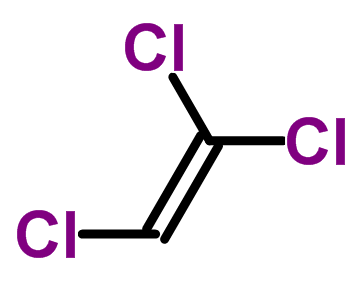In 2012, the Environmental Protection Agency (EPA) released a list of 83 chemicals identified for further investigation under the Toxic Substances Control Act (TSCA).
Of those chemicals, Trichloroethylene (TCE) received a hazard rating of 3, meaning high level hazard concern for both human health and environmental toxicity.
The EPA chose to review TCE because of its probability to cause cancer, coupled with its wide use as an industrial solvent degreaser, protective aerosol coating, and spotting agent.
After a thorough assessment of the chemical, including an external peer review, the EPA released its final risk assessment on TCE last month.
Trichloroethylene
 The Agency for Toxic Substances & Disease Registry (ATSDR) describes TCE as a non-flammable, colorless liquid with a somewhat sweet odor that is mainly used as a solvent to remove grease from metal parts.
The Agency for Toxic Substances & Disease Registry (ATSDR) describes TCE as a non-flammable, colorless liquid with a somewhat sweet odor that is mainly used as a solvent to remove grease from metal parts.
The International Agency for Research on Cancer (IARC) ranks TCE in Group 1, classified as Carcinogenic to Humans and should be considered a potential occupational carcinogen.
The following chart outlines the current exposure limits set for Trichloroethylene.
Agency |
Exposure Limit |
Occupational Safety & Health AdministrationGeneral Industry |
100 ppm (TWA); Exposures shall not exceed 200 ppm (Ceiling) with the following exception: Exposures may exceed 200 ppm, but not more than 300 ppm (peak) for a single time period up to 5 minutes in any 2 hours. |
American Conference of Governmental Industrial HygienistsThreshold Limit Value |
10 ppm (TWA)25 ppm (STEL) |
National Institute for Occupational Safety and HealthRecommended Exposure Limit |
2 ppm (1-hour Ceiling) as an anesthetic agent25 ppm (10-hour TWA) all other exposures |
It should be noted that OSHA regulations are more than 40 years old and based on dated research. Newer standards, such as NIOSH and ACGIH, tend to recommend stricter exposure limits due to more recent research on the health effects of human exposure to chemical fume.
Risk Assessment
The EPA focused their study on the effects of TCE exposure in these categories:
- Commercial use of TCE as a solvent degreaser
- Consumer use of TCE as a solvent degreaser
- Consumer use of TCE as a spray‐applied protective coating for arts and crafts
- Commercial use of TCE as a spotting agent at dry‐cleaning facilities
The following statements are excerpts from their report:
- The main route of exposure to TCE is believed to be inhalation for the uses identified in this assessment.
- TCE is carcinogenic to humans by all routes of exposure as documented in the assessment. This conclusion is based on strong cancer epidemiological data that reported as association between TCE exposure and the onset of various cancers, primarily in the kidney, liver and the immune system.
- Many of the commercial vapor degreasing and spot cleaning exposure scenarios exceed the excess lifetime cancer risk probabilities.
- The commercial vapor degreasing and consumer spray degreasing exposure scenarios show greater acute risks for developmental effects than those reported for the spot cleaning exposure scenarios.
- The greatest concern is for developmental effects, followed by kidney effects and then immunotoxicity, with an overall higher chronic risk for the degreaser exposure scenarios. In general, this concern is present for lower and upper-end exposures and in the presence or absence of room ventilation (LEVs vs. no LEV).
Precautions
It is important to review all of the safety material provided with a degreasing product.
Upon review of a global chemical company’s Trichloroethylene-based metal degreasing product’s Safety Assessment Sheet, we found that they recommend “adequate ventilation be provided in the workplace to minimize the possibility of inhalation, which may be hazardous.”
In addition, the assessment sheet also warns that “the initial effects of excessive inhalation
exposure are dizziness, loss of coordination, sleepiness and symptoms of anesthesia. Excessive exposure may cause systemic injury or even death.”
Industrial Hygiene Testing
At Sentry Air Systems, we are continually testing our products for efficiency against chemical fumes and various particulate.
Our granule activated carbon filters have proven exceptional against common hazardous chemical fumes like sulfur dioxide, methylene chloride, hydrochloric acid, and others.
We are in the process of planning a similar test to see the efficiency of our carbon filters against TCE fume. Stay tuned for more details.
Resources
EPA Consumer Fact Sheet on Trichloroethylene (TCE)
Contact Us
For more information contact Sentry Air Systems at 800.799.4609, email sales@sentryair.com, visit our website or fill out the feedback form below.

 Made in the USA
Made in the USA